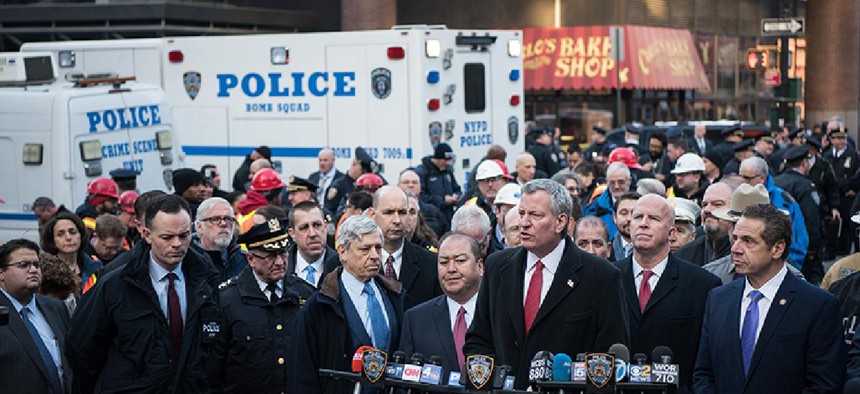Around 7:20 a.m. Monday, a man detonated a pipe bomb attached to his body in the subway corridor connecting Times Square and the Port Authority Bus Terminal. At 7:44 a.m., @NYPDNews, the official Twitter account for the New York City Police Department, tweeted that the NYPD was “responding to reports of an explosion of unknown origin at 42nd Street and 8th Ave.,” and that certain subway lines were being evacuated.
The NYPD is responding to reports of an explosion of unknown origin at 42nd Street and 8th Ave, #Manhattan. The A, C and E line are being evacuated at this time. Info is preliminary, more when available. pic.twitter.com/7vpNT97iLC
— NYPD NEWS (@NYPDnews) December 11, 2017
That tweet, the first in a thread of tweets providing further information on the situation, has been liked 6,000 times and retweeted 10,000 times. According to Detective Scott Glick, who helps to run the department’s social media, Twitter and Facebook are increasingly important tools communicating with the public.
RELATED: Former NYPD police chief Bernard Kerik on the latest attacks
“The NYPD wants to be the source that people are coming to for accurate and timely information,” said Glick, who has been helping to run the NYPD’s social media since 2012. He calls himself a “cog in the wheel” of a communications team that includes the offices of the deputy commissioner for public information and deputy commissioner for strategic communications.
Glick emphasized the importance of putting out accurate information during emergency situations like the one on Monday, and sees the social media accounts as a tool for reassuring the public and combating misinformation.
“First and foremost, we want to keep people safe, but they have to feel safe also in New York City,” he said.
When there is an emergency situation, Glick explained that the NYPD works to quickly provide updates without jeopardizing the investigation, with involvement “all the way up to the deputy commissioner of strategic communications or the deputy commissioner of public information, and the police commissioner.”
The department’s social media presence has evolved in the past few years, as every precinct now has a Twitter or a Facebook account. Glick said that this fits into Police Commissioner James O’Neill’s “neighborhood policing” initiative, providing yet another space for the public to connect with the department.
“Commissioner O'Neill is very supportive of it, and the executive staff is very supportive of it, and all of the precinct commanders are supportive of it, and know the importance of not only putting out that accurate timeline information but also connecting with people on the platform they're on,” he said. “This doesn't replace that face-to-face connection, but it only enhances it when people meet police officers.”
Glick said that social media “nudges” people to be more connected to their local police officers, by allowing the police and the community to meet on a new platform. If someone sees an officer that they recognize from Twitter during an emergency, or simply when passing them on the street, they may feel more comfortable interacting with them.
“We know that the NYPD cops are always willing to say hi and stop and talk,” Glick explained.
RELATED: Training civilians as first responders
After the attack on Monday, the @NYPDNews Twitter handle continued to provide updates on the situation throughout the day and week, linking to press conferences and statements from city leaders. Akayed Ullah, the bombing suspect, who was one of only four injured in the attempted attack, faces terrorism charges.
The emergency this week demonstrates how the NYPD is using social media to provide information and connect with the public.
“I think that most of the people that run the social media – they too are New Yorkers, they're all part of a community also,” Glick said. He sees social media as an opportunity for citizens to familiarize themselves with the department and recognize their “shared responsibility” in reporting suspicious behavior.
“We can't do it without them, and by connecting on social media, it's just another way for the police department to engage with the community that they serve and have them help us as much as we help them,” Glick said.


